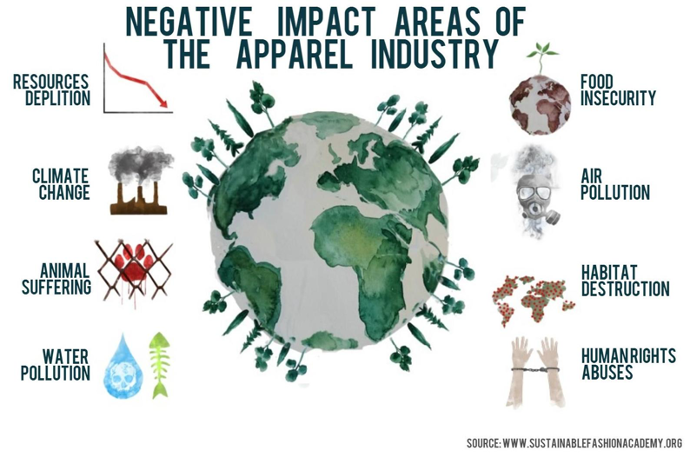The environmental impact of clothing

It is a new week! A week that will be focused entirely on our environment. And what is more important than the environment, our planet?
Do you know already know a lot about the environmental footprint of clothing?
Before I get started, I want to tell you something. I am assuming that you love to go shopping for a day with your friend, being updated on the newest trends and rocking that new look.
But…. did you realise that buying 1 single new t-shirt from H&M already has a big consequence?
The production of the cotton for 1 single t-shirt can already take up 2.700 liters of water.
2.700……
That is enough for a person to drink 3 liters of water a day for almost 2.5 years! And that is not for a whole wardrobe, no, that is just for one t-shirt instead.

Now think out loud how many shirts +- you have purchased throughout your life. You will realise that things really start to add up… At least, I did, when I thought about it myself 3 years ago.
Besides water usage, there are multiple other negative impacts that the polluting clothing industry has on our planet.
These are among other things; resources depletion, climate change, animal suffering, water pollution, food insecurity, air pollution, habitat destruction, human rights abuses.
In the above image at the start of this post, you see the small visualisations of these areas that negatively affect our environment.
In today’s post, I will dive into 3 areas that right now seem the most relevant to me to mention. Besides water pollution (1) — which I introduced in the small introduction of this post — I will also discuss air pollution (2) and human rights abuses (3).
To make it a little easier for you to understand, I divided this little story into a clothing piece that is frequently bought by you, for sure ;)
The environmental impact of a t-shirt

Let’s get started with that t-shirt and its water usage (1). Growing cotton for the clothing industry requires a lot of water.
To give you an idea, the number of inhabitants of Utrecht in 2020, is 357,694 — measured by Gemeente Utrecht.
Let’ assume for now, that each person purchases 2 new t-shirts per year, meaning that (357,694 x 2 = ) 715,388 are being purchased per year, in Utrecht only.
It can take 2,700 liters of water to produce cotton for a single t-shirt. Given this fact means that in total — us at the inhabitants of Utrecht - buying 2 t-shirts a year, takes up 1.931.547.600 liters of water.

931.547.600…... All this water use is definitely putting a strain on our natural resources.
Then, on to a t-shirts’s gas emissions, also referred to as air pollution (2).
How big is the carbon footprint of your t-shirt? How big of an impact do we have on the environment?
I can tell you that 52% (that is 1,22 kg) of the total footprint from a t-shirt your responsibility is in wearing, washing, ironing and drying.
A t-shirt contributes 0.1 kilogram of carbon dioxide per wear. And that happens just from dyeing alone. From the moment the shirt is being produced until it arrives in your hands, about 7 kilograms of CO2 is generated.
cultivating cotton — production — processing — dying — manufacturing and sewing — packing, storage and shipment
Also, did you know that a darker t-shirt causes double the amount of CO2?
However, you should know that the carbon footprint of a piece highly depends on the material. A polyester shirt for instance has a greater carbon footprint than a cotton shirt (5.5 kg vs. 4.3 kg).

Then, on to the third area, being human rights abuses (3).
Fast fashion has pushed companies to find the cheapest possible sources of labour. In fact, the ILO estimates that 170 million are engaged in child labour — many making garments to satisfy our gigantic demand that is part of the clothing industry.
Child labour is a particular issue for the fashion industry, because many parts of the supply chain require low skills that are sometimes even better suited to children because of their smaller fingers that will not damage the crops.
Employers get away with it easily because the supply chain of the fashion industry is way too complex and hard to control. Even though child labour is forbidden by law in most countries, it continues to happen within the fashion industry in poorer parts of the world. Many organisations claim that they have signed the agreement for ‘clean clothes’. However, this appears to be very hard to control and check upon.

The question you might have right now; “how do I know if there have been involved children during the production process”?. Unfortunately, as sad it is, It is very hard for you to find out….
That was a lot of information, wasn’t it?
I will always remember my little sister saying “oh well, then I will just try to reduce the number of t-shirts I am buying”. Unfortunately. I had to wake her up from this dream, because these big consequences are not only created by the production processes of t-shirts.
Just to give you a quick example of the environmental impact of one of your favourite pair of sneakers;

The sneaker production is exceptionally carbon intensive, accounting for already 1.4% of the global greenhouse gas emissions.
Let’s compare this to something else to make it a bit easier to understand; the whole air travel is responsible for 2.5% of all emissions, that is only 1.1% more!
Pretty confronting, right? The plastic of plastic-like materials used in shoes also produce high numbers of carbon dioxide.
Vintage Clothing
As you just read, the production of new clothes has such a big negative impact on our planet.
All this is significantly smaller when you buy vintage clothing. The whole process of new production of clothes will not start all over again when buying reused clothing items.
How does that sound? Good to my ears! That is why I believe we should try to convince all our friends and family to go vintage; we are all in this together. Together we can make this world a better place!
Would you, your friend, or your family member — after reading this — like to know more about the other topics that I have not talked about today? If you are not so sure, have a look again at the picture at the very start of this post!
And please do not hesitate to leave a comment! I am more than happy to provide extra information on topics that you are interested in :)
I really cannot wait to see you all again this Friday!
In case you are interested, do not forget to follow me on Instagram as well for similar content on vintage clothing! https://www.instagram.com/ut_vintageclothing/
Go Vintage with us!
Sources: World Resources Institute. National Geographic. The Guardian.
